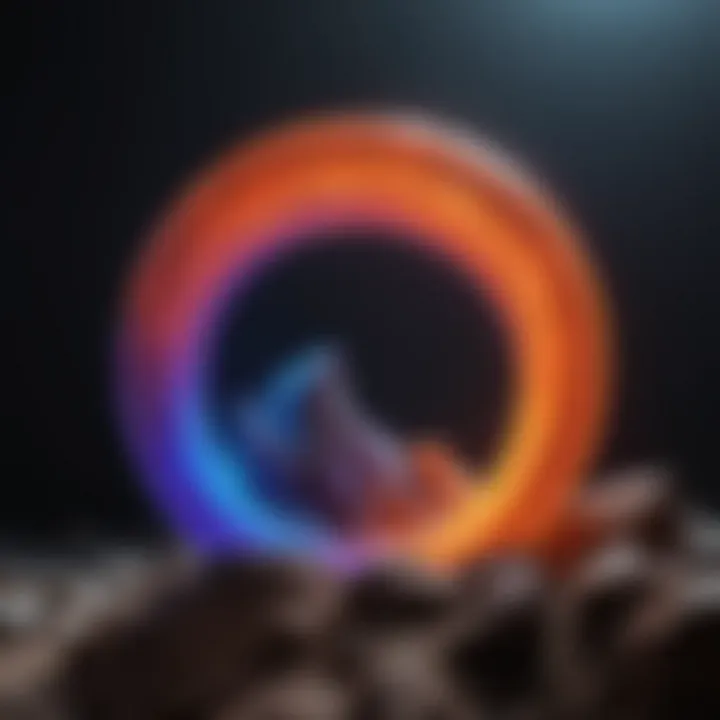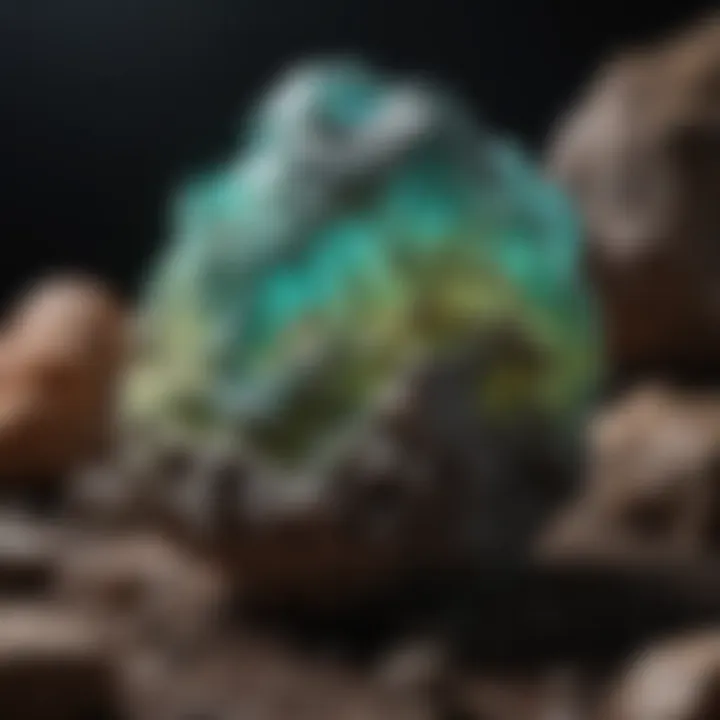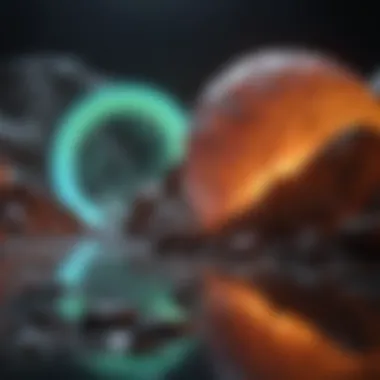Understanding UV Light: Glow in the Dark Science


Intro
When it comes to the fascinating aspects of nature, UV light and its ability to induce a glow-in-the-dark effect certainly ranks high on the list. This effect is not just a whimsical display; it’s grounded in the rich tapestry of physics and chemistry. Understanding this phenomenon offers a glimpse into how light interacts with various materials, revealing properties that have both scientific significance and practical applications.
UV light, or ultraviolet light, exists just beyond the visible spectrum. To the naked eye, it’s invisible. Yet, despite its unseen nature, this form of light is vital in numerous fields. Understanding UV light invites us into a realm where the invisible becomes captivating. It’s more than just a topic for scientists or hobbyists; it opens doors to exploring our world in a fundamentally different way.
This article will unpack the intricacies of luminescence—the process by which materials emit light after absorbing energy—and delve into different materials that glow in the dark. Emphasizing phosphorescence, we’ll explore how some substances continue to emit light for an extended time after the initial energy source is removed. These principles come together to inform various applications, particularly in geology and paleontology, where they unearth secrets from the past.
So, let’s dive into an exploration of UV light and its captivating glow and see how this phenomenon can illuminate the world of rock and fossil collectors.
Preface to UV Light and Luminescence
Understanding the nuances of UV light and luminescence serves as a beacon for enthusiasts like rock and fossil collectors who seek to bridge the gap between the scientific and the spectacular. With a blend of natural curiosity and a thirst for knowledge, this section sets the stage for exploring a fascinating realm where science meets nature's art. The interplay between UV light and luminescence is not just a mere curiosity; it holds the potential to unveil hidden properties of materials, enriching the experiences of those delving into the world of geology.
Definition of UV Light
Ultraviolet (UV) light is a form of electromagnetic radiation with wavelengths shorter than visible light, lying in the range of approximately 10 nm to 400 nm. This invisible spectrum is categorized into three groups based on wavelength: UVA, UVB, and UVC. While UVA can penetrate deep into the skin and may contribute to premature aging, UVB is known for its role in vitamin D synthesis and is essential in life. UVC, being the most harmful, is mostly absorbed by the Earth’s atmosphere, making natural exposure negligible. In the context of luminescence, UV light plays a pivotal role as it excites atoms and molecules, leading to impressive light displays.
Understanding Luminescence
Luminescence involves the emission of light from a substance not resulting from heat. The phenomenon can be observed in various contexts, such as bioluminescence found in certain organisms and photoluminescence which occurs upon excitation by photons. The glow seen in many minerals and compounds when exposed to UV light showcases the efficiency of these emissions. This property has a broader significance in fields like geology, paleontology, and even art as it provides insights into the composition and history of materials. Understanding luminescence goes beyond visual appeal; it offers a glimpse into the intricate workings of natural elements that pique the interest of collectors and researchers alike.
The Role of Photons
In the pursuit of understanding luminescence, photons emerge as the key players. These tiny particles, which embody the quantum of light, interact with materials to produce excitation. When photons strike certain substances, they can elevate electrons to higher energy levels. This process sets the stage for the trademark luminescence seen in many minerals. When these energized electrons return to their ground state, they release energy in the form of visible light. Thus, the role of photons is not just incidental; it is fundamental in triggering the glow that captivates our imagination. Their interactions with matter exemplify how intricate and interconnected the laws of physics are with the world around us.
"Photons are the unsung heroes behind luminescence, igniting the transformation from invisible light to visible glow."
In summary, this initial exposition on UV light and luminescence lays the groundwork for more detailed explorations. It opens the door to understanding the mechanisms that cause materials to shine under specific conditions and highlights the relevance of these phenomena in practical applications for rock and fossil collectors. The journey closer to the glowing mysteries of nature begins here, inviting an inquiry into the dazzling world of luminescent materials.
Mechanisms Behind Glow in the Dark Effects
The understanding of how glow-in-the-dark effects operate significantly enhances our grasp of UV light's applications. The mechanisms involved showcase the fascinating interplay of energy and materials, revealing why some substances exhibit luminescence while others remain inert. This section delves into the types of luminescence, energy transitions, and the excitation and emission of electrons. Together, these elements form the backbone of glow-in-the-dark phenomena, serving various needs across multiple fields.
Types of Luminescence
Luminescence is a captivating natural process that manifests in various forms, each with its own unique characteristics and applications.
Fluorescence


Fluorescence is the type of luminescence that occurs almost instantaneously. When a material absorbs ultraviolet light, it re-emits that energy as visible light, but only while it is being exposed to the UV source. This trait makes it a go-to choice for many applications, from security measures to artistic displays.
A key characteristic of fluorescence is its rapid response—often in nanoseconds. This immediacy allows it to be vividly present during black light parties or at concerts where UV lighting is utilized.
One of the unique features of fluorescence is its broad range of colors and hues that can be produced, appealing to artists and designers alike. On the downside, this type requires continuous exposure to UV light to maintain its glow, which can limit its practical use in settings where consistent light is not available.
Phosphorescence
Phosphorescence stands apart from fluorescence in that it can continue to emit light even after the initial excitation source has been removed, creating a lingering glow. This is accomplished through a process known as ‘triplet state’ which allows the excitation energy to be stored for a longer period of time.
This property makes phosphorescent materials incredibly useful for safety and decorative items, like glow-in-the-dark stars on ceilings or exit signs, which remain visible in the absence of light. A characteristic feature is its
Materials that Glow in the Dark
The exploration of materials that exhibit glow-in-the-dark properties is vital to understanding how UV light interacts with different substances. These materials not only have captivating visual effects, but they also offer unique benefits across various applications, such as safety, art, and science. By studying these materials, rock and fossil collectors can gain insights into geological formations and the interactions that occur in nature. In addition, understanding these materials helps inform sustainable practices and advancements in technology.
Phosphorescent Materials
Phosphorescent materials are those that absorb UV light and re-emit it over time, creating a glow that can last for minutes or even hours after the initial exposure to light. These materials are commonly used in various products like glow-in-the-dark paint, toys, and safety signs. One significant advantage of phosphorescent materials is their ability to provide visibility in dark environments, thus enhancing safety in emergency situations. Moreover, they are often non-toxic, making them suitable for diverse applications, including children’s items.
Fluorescent Pigments
On the other hand, fluorescent pigments behave differently compared to their phosphorescent counterparts. When exposed to UV light, they instantly emit light but do not continue to glow once the source is removed. These pigments are frequently used in artistic endeavors and fashion, creating vibrant displays that pop under UV light. A key characteristic of fluorescent pigments is their capacity to absorb specific wavelengths of light, usually in the UV range, while emitting a visible spectrum. This makes them particularly useful in settings like nightclubs and outdoor festivals.
Minerals and Their Properties
Calcite and Fluorite
Calcite and fluorite are fascinating minerals with unique glowing properties, making them significant for both collectors and researchers. Calcite, known for its ability to react to UV light, can exhibit various vibrant colors, depending on impurities present in the crystal lattice. Its key characteristic of birefringence, or double refraction, also provides an opportunity to study optical phenomena.
Fluorite, with its strong fluorescence under UV light, is a popular choice among rock hounds and mineral collectors. Its unique feature lies in its composition, which allows it to emit beautiful colors when illuminated. The ability of fluorite to exhibit a wide range of colors makes it a desirable specimen, captivating many who seek to understand its formation and properties. However, collectors should be aware that both minerals can be sensitive to acids and wear over time, so proper care is necessary to maintain their integrity in a collection.
Zinc Sulfide and Strontium Aluminate
Zinc sulfide and strontium aluminate are two more materials with remarkable luminescent properties. Zinc sulfide is an older phosphorescent material, capable of glowing for a shorter duration than its contemporary counterpart, strontium aluminate. The latter has become the gold standard in glow-in-the-dark technology due to its remarkable brightness and longevity.
Strontium aluminate is often used in applications that require glowing effects to persist longer, thus offering an advantage over zinc sulfide in various situations. However, zinc sulfide still holds value, particularly in retro applications or artistic settings where a softer glow is preferred.
"Understanding the properties of these materials allows collectors and enthusiasts to appreciate not just their beauty, but also the science behind their luminescence."
In summary, the study of materials that glow in the dark highlights the intersection of science and aesthetic appeal. From phosphorescent materials that light up over time to minerals rich in history, each offers a unique perspective on the broader narrative of luminescence.
Applications of Glow in the Dark Technology
The realm of glow-in-the-dark technology offers a fascinating blend of functionality and intrigue that extends far beyond novelty items and children’s toys. The ability of materials to absorb light and re-emit it in low-light conditions has become increasingly relevant in various sectors, showcasing the versatility and advantages of these luminous substances. For rock and fossil collectors, the relevance becomes apparent, as the technological applications not only enhance safety but also enrich understanding and appreciation of geological specimens.
Safety and Emergency Signage


In critical situations, the utility of glow-in-the-dark materials shines brightly, literally and figuratively. Emergency signage that utilizes luminescent technology plays an essential role in guiding individuals to safety during power outages or emergency evacuations. When traditional lighting fails, these signs often continue to illuminate pathways, exit routes, and other important notifications, thus reducing panic and confusion.
For instance, exit signs made from phosphorescent materials can absorb ambient light and provide visibility in dark conditions. By using colors like green or yellow, these signs can become not just functional but effective signaling elements in smoky or dim environments.
"Safety isn't just about being prepared for the worst; it's about having systems in place that can react when the lights go out."
Benefits:
- Visibility in Darkness: Glow-in-the-dark materials ensure that crucial information is accessible even when visibility is compromised.
- Minimal Maintenance: Unlike electric signs, these require little upkeep and are not dependent on electricity.
- Cost-Effective Solutions: Using luminescent materials can minimize long-term costs associated with energy consumption.
Decorative Elements in Art and Design
Beyond safety, glow-in-the-dark technology has carved out a unique niche in art and design, captivating audiences with its mesmerizing aesthetic appeal. Artists and designers are increasingly incorporating luminescent materials in their work to create environments that transform under different lighting conditions.
From murals that come alive at night to intricate sculptures that cast subtle glows, these materials enable creative expression that resonates with the public. For a rock or fossil collector, incorporating glow elements into displays can highlight the geological narrative in vivid ways. Imagine mineral specimens that reveal hidden textures and features through their luminescence, thus telling a more layered story about their formation.
Key Considerations:
- Material Versatility: Various materials like pigments, polymers, and glass can be engineered to produce unique glow effects.
- Interactive Experiences: Artists can design installations that encourage viewer interaction through a shift between light and dark.
- Cultural Significance: Many cultures utilize luminescence in traditional crafts, thus marrying modern technology with historical artistry.
Scientific Research and Education
In academic environments, the implications of glow-in-the-dark technology extend into scientific research and education, fostering a deeper comprehension of principles such as phosphorescence and fluorescence. Educators can leverage these materials to create engaging learning experiences, allowing students to witness firsthand the fascinating properties of different minerals.
For geology enthusiasts, using glowing minerals in educational displays aids in illustrating concepts of mineral formation and energy transfer. Furthermore, it helps in categorizing specimens based on their luminescent properties, enriching the collector's perspective and knowledge.
Applications in Research:
- Field Studies: Natural luminescence in minerals can provide clues to their geological history, helpful for researchers and collectors alike.
- Hands-On Learning: Interactive educational tools can enhance subject comprehension through visual stimulation and practical observation.
- Promoting Conservation Awareness: As part of educational exhibits, glow-in-the-dark materials can draw attention to the need for preserving geological sites and collections.
The applications of glow-in-the-dark technology reflect a multifaceted approach that intertwines safety, aesthetics, and education. With ever-evolving advancements, the potential for these materials continues to expand, promising exciting prospects not only for rock and fossil collectors but also for broader audiences.
Environmental and Health Considerations
The intersection of UV light with environmental and health aspects holds significant weight for our modern society. As we delve into the world of glow-in-the-dark technologies, it's crucial to scrutinize how these phenomena impact both human health and the environment. Examining the repercussions of UV exposure and the sustainability of materials used offers a comprehensive look into responsible development and usage.
The Impact of UV Light on Health
UV light, often sneered at for its harmful effects, can be a double-edged sword. While beneficial in moderation—such as stimulating vitamin D production—it can also lead to adverse health effects, particularly overexposure. This is notably significant for those in fields where UV light is prevalent, like geology and paleontology.
Regular exposure to UV radiation can cause skin damage, which is notably concerning for those who spend extended hours outdoors collecting specimens. Skin cancers, such as melanoma, are linked to UV exposure, prompting many to adopt preventive measures. Moreover, UV radiation might affect eye health, leading to conditions like cataracts over time.


"Awareness is key; protecting oneself from the sun's harmful rays can mean the difference between a lifetime of health and a season of regret."
Ultimately, understanding the nuances of UV exposure is vital. Collectors must remain vigilant about skin protection and seek shaded areas during peak UV times, helping mitigate the health risks associated with prolonged exposure.
Sustainable Practices in Material Production
As we navigate the implications of materials that exhibit glow-in-the-dark properties, the sustainability aspect cannot be overlooked. The production processes associated with luminescent materials can often leave a considerable environmental footprint. This brings forth the need for innovative and environmentally conscious production methods.
Manufacturers are increasingly prioritizing the sourcing of raw materials in ways that ensure minimal ecological disruption. This includes using recycled materials and incorporating eco-friendly chemicals in their formulations. For example, some newer phosphorescent pigments come from sustainable sources, ensuring that their production does not contribute to ecological degradation.
To make informed choices, consumers, especially rock and fossil collectors, must advocate for transparency from suppliers regarding the origins and environmental impact of their materials. This can create pressure for companies to adopt practices that align with a healthier planet.
Regulations Concerning UV Exposure
Understanding the frameworks surrounding UV exposure regulations is paramount for those interacting with UV light, especially in commercial contexts. Governing bodies have established guidelines to safeguard individuals by regulating the maximum allowable UV output from devices. These regulations vary by country but often fall under occupational safety standards.
In many cases, organizations are required to provide training and equipment to mitigate exposure, ensuring that workers are not at risk. For the rock and fossil community, adhering to these regulations is crucial when using UV lamps for specimen examination. It is wise to consult regulations from organizations like the Occupational Safety and Health Administration (OSHA) to stay informed about best practices.
By understanding the complexities of UV light's impact—its health implications, the necessity for sustainable practices in material production, and the relevant regulations—individuals can navigate their interests in geology and paleontology with a greater awareness and responsibility.
Future Trends in Glow in the Dark Innovations
As we stand at the crossroads of science and creativity, the future trends in glow in the dark innovations bring with them untold possibilities for industries ranging from art to safety. This section highlights the significance of this topic, aiming to provide a roadmap for how advancements in materials and technology might revolutionize our daily environments. The projected innovations not only encompass improved functionality of glowing materials but also address environmental and health considerations, positioning glow-in-the-dark technologies as a pivotal player in future trends.
Advancements in Material Science
The backbone of glow-in-the-dark products lies in sophisticated material science. Researchers are constantly exploring new compounds and methods to enhance luminescence. One notable trend is the development of nanomaterials, which have shown promise in amplifying the brightness and longevity of glow effects. These materials, such as quantum dots, are small enough to have unique optical properties compared to their larger counterparts.
Additionally, innovations in phosphorescent materials are paving the way for brighter, longer-lasting effects. Certain research teams are experimenting with new phosphorescent agents that can absorb light more efficiently, which could result in products that glow more vividly without requiring extensive light exposure. This can be particularly advantageous for applications in safety signage where visibility can mean the difference between danger and peace of mind.
Integration in Modern Technology
The integration of glow-in-the-dark features into modern technology is no longer a mere curiosity—it's becoming increasingly common. Imagine smartphones that glow softly in the dark, guiding users to their devices or alerts that become visible in low light. Similarly, advancements in wearable technology are yielding products with luminescent properties, enhancing user visibility during nighttime activities like jogging or cycling.
Moreover, smart home systems are beginning to incorporate glow-in-the-dark components to illuminate essential controls or pathways without energy consumption. This can lead to more energy-efficient homes and help individuals save on electricity bills while promoting safety.
"Glow-in-the-dark technology is not only about aesthetics; it's about creating safer, smarter environments."
Potential Uses in Everyday Life
The potential applications of glow in the dark technologies are vast, touching nearly every aspect of everyday life. For instance, in educational settings, glow-in-the-dark materials can be utilized for teaching geology. Imagine rock samples that emit a soft glow under UV light, captivating the attention of students while demonstrating concepts of luminescence and mineral properties.
In the realm of design, artists are beginning to incorporate luminescent paint and materials into their work, creating pieces that change appearance once the lights go dim. This adds a layer of interactivity and excitement to art displays, transforming how viewers engage with visual experiences.
Moreover, the healthcare sector is also a beneficiary. While providing patients with glow-in-the-dark medical devices can help locate critical equipment in emergencies, it’s the incorporation of glow properties into surgical tools that promises exciting developments. Tools that glow under specific lights can ensure better precision during complex operations and enhance safety protocols.
As glow-in-the-dark innovations continue to evolve, they promise not only to enrich our environments aesthetically but also to enhance safety and utility. The unending creativity in merging luminescence with the latest technological advancements guarantees that glow-in-the-dark solutions will light our way to a brighter and safer future.



